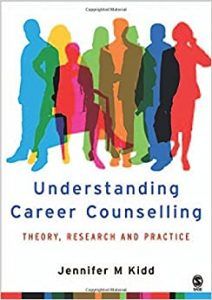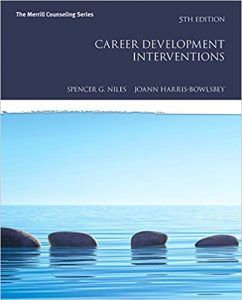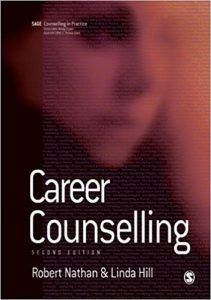Career Counseling Resources: 10 Techniques for Your Sessions
 Throughout our lives, we are likely to be troubled with questions or experience self-doubt regarding career choices and what to do next.
Throughout our lives, we are likely to be troubled with questions or experience self-doubt regarding career choices and what to do next.
We may turn to friends, family, and even colleagues for advice regarding our lack of career advancement or dissatisfaction regarding our current career path (Nathan & Hill, 2006).
Dedicated career counselors are available and provide professional advice on career decisions, coping with change, job searching, and identifying learning opportunities (Niles & Harris-Bowlsbey, 2017).
This article introduces resources to help career counselors provide the necessary career interventions to help clients find that path.
Before you continue, we thought you might like to download our three Strengths Exercises for free. These detailed, science-based exercises will help your clients realize their unique potential and create a life that feels energizing and authentic.
This Article Contains:
- A Look at Career Counseling Sessions
- 3 Useful Interventions & Treatment Plans
- Top 2 Techniques and Strategies to Apply
- 3 Worksheets & Relevant Resources
- 2 Best Activities for Individuals & Groups
- Our 3 Favorite Books on the Topic
- 3 Apps to Download Today
- PositivePsychology.com’s Helpful Tools
- A Take-Home Message
- References
A Look at Career Counseling Sessions
Clients engage career counselors for many reasons in a variety of situations. Each setting requires specialist support from the counselor and interventions appropriate to their clients’ needs, including (Niles & Harris-Bowlsbey, 2017):
- Elementary school
Helping children investigate the world of work and consider career choices based on their growing self-knowledge. - Middle and high school
Assisting students in understanding the relationships between meaningful school work and later work choices, and making informed school choices that prepare them for possible occupations. - College
Helping students understand the job market, assume personal responsibility for career choices, create an effective resume, and prepare for job interviews. - Community agency
Assisting adults who wish to pursue alternate occupations by setting career goals and identifying forces that help or thwart change.
A practical career counseling example
In the following example, a corporation has engaged a career counselor to support mid-level managers facing lay-offs. The typical objectives and structure for career counseling sessions may look like the following (modified from Niles & Harris-Bowlsbey, 2017):
Summary of objectives
A summary of objectives for employees soon to be terminated may include helping them:
- Recognize that the situation they face results from economic pressure rather than personal performance.
- Accept that while the situation is upsetting, it is not catastrophic. New opportunities will arise.
- Create an up-to-date resume that reflects their skills, abilities, and work history.
- Practice and participate in mock interviews.
- Find effective ways to identify job opportunities.
- Develop a plan for transition.
Session plan
The following example session plan supports these objectives:
- Session one
Provide an opportunity for employees to talk about how they feel and express their anger and even grief regarding their job loss. Most likely, the session will be in a group setting, with management from the corporation invited to attend to offer timing and information regarding the forthcoming changes. - Session two
The next session might be more structured and involve working with individuals or small groups to create a resume and receive feedback from the counselor. The aim is to capture who they are at their best, along with skills and experience gained through their career so far. - Session three
This session might include an opportunity to learn effective interviewing skills, including role-play in a group setting on both sides of the interview. The session may also involve honing internet research skills to identify potential employers. - Session four
The final session may focus on finding opportunities using the latest tools, along with agencies, networks, and direct applications. Sharing in a group setting can be particularly beneficial, but there may be some reluctance because of competition for new roles.
The overview above is one of many possible sets of intervention sessions. Each must be made individual and specific to the situation and client (both employer and employee).
3 Useful Interventions & Treatment Plans

Career counseling treatment plan
While career counseling should be specific and individual to the client, assessments and interventions typically include the following five stages (modified from Nathan & Hill, 2006):
- Exploring: Who are they?
Getting to know the client, including relevant past experiences and where they are now. - Clarifying: What do they want?
Understanding the client’s hopes, dreams, and aspirations. - Identifying options: What are their options to move forward?
Recognizing their options for working toward goals. - Identifying blockers: What stops them from moving forward?
Recognizing what is stopping or could stop them from achieving their goals. - Action planning: What steps do they need to take?
Defining and agreeing on the action steps that will help the client deliver on their career aspirations.
Each stage may take place over multiple sessions and should be revisited as new understandings and information arise.
Providing emotional support
Emotional support given to clients can help them feel like they matter and remain relevant to the workforce. However, this requires skill and good intention from the counselor to stay genuine and authentic (Niles & Harris-Bowlsbey, 2017).
The acronym PLEASE is a helpful aid and treatment plan for supporting clients (modified from Niles & Harris-Bowlsbey, 2017):
- Protecting
Ensure that the client receives all the counseling benefits and help to which they are entitled. - Listening
Take time to listen actively to the client’s story and how they feel. - Enquiring
Be naturally curious. Use questions and prompts to express interest in their story. - Acknowledging
Greet and notice the client using verbal and nonverbal signals. - Supporting
Encourage and praise their efforts. Be positive and provide helpful feedback. - Exchanging
Share information about yourself and your own career path, if appropriate.
Dialogue should remain flexible and not prescribed. The aim is to support the client and ensure they feel they matter.
Forming a picture of the client
While there are several approaches to career counseling, the counselor usually begins by forming a picture of the client’s self-observations and career beliefs. The counselor develops an understanding based on the following (modified from Niles & Harris-Bowlsbey, 2017):
- How does the client describe themselves?
This may include racial-ethnic identity, health and physical status, family situation, educational background, etc. - How does the client feel about the process of career development or career change?
For example, what goals do they or their family have for themselves? - Are the client’s beliefs helpful (functional) or unhelpful (dysfunctional)?
- Which learning experiences have been formative in their career development?
It is helpful to be aware of and understand previous roles, past successes, and role models.
Early sessions in career counseling should center around understanding the client’s current situation, background, and future aspirations.
Top 2 Techniques and Strategies to Apply
The following two techniques are powerful approaches to narrow down where the client is and what they want from their career.
FIRST framework
Career counseling techniques are “more effective when they are in line with the client’s developmental stage” (Kidd, 2014, p. 22).
The framework that follows the acronym FIRST (focus, information, realism, scope, and tactics) is a helpful and practical tool for understanding the client’s existing developmental stage.
Use the FIRST Framework Questions worksheet to ask the client a series of career counseling questions to understand where they are in their career thinking; for example (modified from Kidd, 2014):
- Focus
How far have you narrowed down your career options? - Information
How well informed are you about the career options you have in mind? - Realism
How realistic are you regarding your abilities and the external constraints (for example, the job market)? - Scope
How aware are you of the range of options available to you? - Tactics
How far have you worked out the practical steps to reach your career objectives?
The counselor assesses the answers to understand how far the client is along the path to a new career decision.
Career ‘wants’
While subjective assessments may not fully capture the skill sets and expertise of clients, they help clarify their wants and needs for current and future roles (Niles & Harris-Bowlsbey, 2017).
The Assessment of Life and Career ‘Wants’ worksheet contains five questions that help clients connect their sense of purpose to the career they wish to pursue.
The answers are valuable for considering how their existing or future career plans meet their needs and wants.
3 Worksheets & Relevant Resources

Career counseling evaluation
Evaluation sheets are crucial for understanding whether clients’ needs are being met and how to improve future interventions.
Provide the client with the Career Counseling Evaluation worksheet, then review and collate the answers to identify how to improve the support provided.
Satisfying achievements at work
Focusing on achievements is a positive way of raising self-esteem and identifying counseling skills that may be useful later in someone’s career (Nathan & Hill, 2006).
The Satisfying Achievements at Work exercise identifies key accomplishments, what was important about each one, and the skills and qualities involved (modified from Nathan & Hill, 2006).
The answers help the client and guide the counselor’s interventions to identify skills and qualities they may wish to use in future roles.
Returning to Work Checklist
If the client has been out of the working environment for some time, perhaps with parental responsibilities or long-term sickness, a return to the workforce may prompt concerns regarding a lack of skills or relevant strengths (Niles & Harris-Bowlsbey, 2017).
Use the Returning to Work Checklist to remind clients of their many strengths and transferable skills from previous employment or in response to their duties outside.
Every person brings with them skills and strengths. The exercise above helps to remind the individual that these skills and strengths may have been developed or practiced outside the workplace.
2 Best Activities for Individuals & Groups
There are typically four stages to group career counseling (modified from Niles & Harris-Bowlsbey, 2017):
- Opening
The group members first meet and receive an overview of the program from the counselor. - Investigation
Discussion of issues and points concerning the groups’ purpose. - Working
Identifying, processing, and synthesizing actions required for career development. - Decision/Operational
Members take actions and support one another.
Most counselors recognize group counseling as an efficient and valuable method of service delivery (Niles & Harris-Bowlsbey, 2017).
The following two activities can be helpful for individuals and groups.
Narrative therapy questioning
Narrative therapy can work well in a group or individual setting. For example, answers to the following prompts regarding key events in a client’s life can indicate dominant themes that impact the present (modified from Kidd, 2014):
- Name a high point.
- Name a low point.
- Name a turning point.
- What is your earliest memory?
- Describe an important childhood memory (positive or negative).
- Describe an important adolescent memory (positive or negative).
- Describe an important adult memory (positive or negative).
- Describe another important memory (positive or negative).
Understanding a client’s narrative can help the counselor make more informed decisions regarding future interventions.
Career Action Plan
Action plans are valuable for turning abstract wishes into concrete goals.
The Career Action Plan worksheet helps users capture goals, turning them into a series of action steps, and commit to work toward them.
Use the worksheet with the client or group within a session, discussing the importance of goals when seeking to progress or change a career (modified from Nathan & Hill, 2006).
Our 3 Favorite Books on the Topic
There are many counseling books available that explore the techniques involved in career counseling; we’ve included three of our favorites below.
1. Understanding Career Counselling: Theory, Research and Practice – Jennifer Kidd
This practical and accessible book takes the reader through the theory, research, and practice of career guidance and career counseling.
Jennifer Kidd’s text provides an invaluable resource for established practitioners and those new to this and related fields.
Find the book on Amazon.
2. Career Development Interventions – Spencer Niles and JoAnn Harris-Bowlsbey
This comprehensive book on modern career development includes theories, assessments, resources, and planning tools to use with clients.
The text includes up-to-date coverage of technologies to help practitioners and clients, including social media for job seeking and to assist the interview process.
Find the book on Amazon.
3. Career Counselling (Therapy in Practice) – Robert Nathan and Linda Hill
This powerful book looks at the practicalities of deciding on and securing a new career and the importance of working with and supporting client feelings.
This practical guide explores all the issues typically brought to career counseling sessions, along with many others that are less common.
Find the book on Amazon.
3 Apps to Download Today
While not purely related to career counseling, the following apps provide valuable tools for promoting career learning, job searching, and securing new work opportunities:
1. LinkedIn
This business-related social network is an excellent resource for the latest industry updates in your chosen field, as well as for finding new and existing connections and opportunities to support you in your search for a new career.
Find the app in the Google Play Store.
Find the app in the Apple App Store.
2. Monster
While hosting a vast job board, Monster also offers tips, tools, and coaching to assist job hunters in preparing for interviews. Along with a clear indication of salaries, this app allows users to upload resumes and pictures through their dedicated portal.
Find the app in the Google Play Store.
Find the app in the Apple App Store.
3. Glassdoor
Not just a powerful app for searching for your next job, Glassdoor provides company reviews, interview tips, and salary insights.
Other highly valued features include interview reviews, interview questions, and expert tips on applying for and landing your next job.
Find the app in the Google Play Store.
Find the app in the Apple App Store.
PositivePsychology.com’s Helpful Tools
We have many tools, worksheets, and exercises available to support you or your client on future career moves and building their role profile.
Why not download our free goal-setting tool pack and try out the powerful tools contained within to help your clients achieve their career aspirations? Here are some example exercises from the tool pack:
- Goal Visualization
Try out this powerful mental imagery exercise to imagine your future success. - Realizing Long-Lasting Change by Setting Process Goals
Setting process goals can lead to the formation of a habit that can culminate in career change.
Other free resources include:
- Workplace Strength Cards
Use these cards to help identify the strengths that apply to a workplace. - Strengthening Ikigai in the Workplace
Use these four crucial questions and the wisdom of ikigai to improve where you work.
More extensive versions of the following tools are available with a subscription to the Positive Psychology Toolkit©, but they are described briefly below:
- Strengths-Based Resume
Build a resume that captures the strengths and experiences that contribute to or enhance your performance and wellbeing using the following steps:
Step one – Map strengths to the job requirements.
Step two – Write an employment history.
Step three – Add strengths to the employment history.
Step four – Ask someone to perform a review.
- The Freelancer Approach
Learn how to step away from a passive relationship with your workplace toward a more active one, helping you target the right jobs and employers.
Imagine running your own business and reflect on the following questions:
-
- How would you behave at work each day if you were self-employed?
- What type of work would you do?
- How would you approach your role?
- How would you treat your colleagues?
17 Strengths-Finding Exercises
If you’re looking for more science-based ways to help others develop their strengths, check out this collection of 17 strengths-finding tools for practitioners. Use them to help others better understand and harness their strengths in life-enhancing ways.
A Take-Home Message
Our careers and how we see ourselves are crucial aspects of our physical and mental wellbeing, providing purpose and meaning in our daily lives.
Career counseling aims to help people achieve their potential and be more satisfied and successful in their work. As such, it remains specific to the individual’s situation, needs, and wants, with no single career path that suits everyone (Nathan & Hill, 2006).
By understanding past successes and achievements, reflecting on where the client is now, and evaluating their career aspirations, it is possible to formulate a plan for what success looks like for them.
Career counseling can also help clients accept that change is often outside their control and not a result of failing performance. Once recognized, the client can identify skills and qualities they wish to use in a future workplace and craft their career journey accordingly.
These techniques, counseling activities, and worksheets help career counselors work with their clients to change or develop a career according to their needs and wishes.
We hope you enjoyed reading this article. Don’t forget to download our three Strengths Exercises for free.
- Kidd, J. M. (2014). Understanding career counselling: Theory, research and practice. SAGE.
- Nathan, R., & Hill, L. A. (2006). Career counselling (2nd ed.). SAGE.
- Niles, S. G., & Harris-Bowlsbey, J. (2017). Career development interventions (5th ed.). Pearson.
Let us know your thoughts
Read other articles by their category
- Body & Brain (49)
- Coaching & Application (57)
- Compassion (26)
- Counseling (51)
- Emotional Intelligence (24)
- Gratitude (18)
- Grief & Bereavement (21)
- Happiness & SWB (40)
- Meaning & Values (26)
- Meditation (20)
- Mindfulness (45)
- Motivation & Goals (45)
- Optimism & Mindset (34)
- Positive CBT (28)
- Positive Communication (20)
- Positive Education (47)
- Positive Emotions (32)
- Positive Leadership (18)
- Positive Parenting (4)
- Positive Psychology (33)
- Positive Workplace (37)
- Productivity (16)
- Relationships (46)
- Resilience & Coping (36)
- Self Awareness (21)
- Self Esteem (38)
- Strengths & Virtues (31)
- Stress & Burnout Prevention (34)
- Theory & Books (46)
- Therapy Exercises (37)
- Types of Therapy (64)








What our readers think
Your information written here has given me a broader insight on the subject matter as a newly appointed counselor in my school. Thanks for helping me.